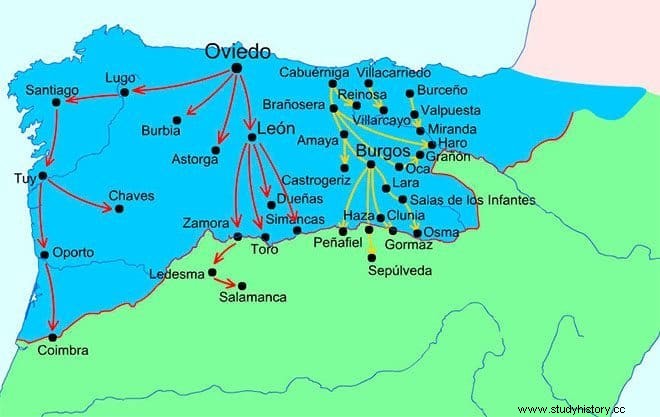The main activity carried out by the Asturian-Leonese kingdom, during the 8th to 10th centuries, was the colonization of the spaces located between the Cantabrian mountain range and the Duero river. This territory, which comprised some seventy thousand square kilometres, included the center and south of Galicia, the Alto Ebro and, above all, the Duero basin.
Traditionally it has been assumed that, since the middle of the 8th century, the Duero basin was uninhabited, due to the march towards the south of the Berbers, that is, the Muslims who had settled in those lands, and the flight towards the north of the Christians. The main defender of this hypothesis was the distinguished medievalist Claudio Sánchez-Albornoz, who relied on both chronicle and toponymic and institutional arguments. Those points of view, however, were discussed in his day by Ramón Menéndez Pidal, who understood that the Latin term populare he did not mean to repopulate, but rather to occupy and organize a territory. But it has been above all archeology that has most criticized the depopulation hypothesis, for which it is based on excavations that reveal, at certain points, a population continuity. In any case, aside from the greater or lesser depopulation of those lands, there is no doubt that the Duero basin was a «no man's land», because since the middle of the 8th century it was not dominated by al-Andalus or by the incipient Asturian kingdom .
Repopulation Process
In any case, there was, without the slightest doubt, an important repopulation process, of which the protagonists were above all people from the other side of the Cantabrian mountain range, who were joined, late in the 9th century, by Mozarabs who left al-Andalus. At first, the repopulation had a spontaneous character, proceeding the peasants, who acted on their own or under the direction of clerics or nobles, to haste, a term that means occupation of a territory and subsequent exploitation of it. Later, from the middle of the 9th century, the Asturian kings decided to intervene in this activity, which explains why there is talk of official repopulation.
The aforementioned colonizing process had, without the slightest doubt, important economic and social consequences. For the time being, there was massive land clearing, while crops were diversified, with cereals and vines gaining weight above all. . In the field of livestock we witnessed in those centuries the rise of the horse, essential for war activities but also the growth of sheep farming, protagonist of the transhumance that took place between the Cantabrian mountains and the Duero valley plains. The rural world exercised an indisputable predominance at that time. Craft and commercial activities, as well as urban life, had, on the other hand, very little prestige. The only examples of significant urban centers, for the 10th century, were Burgos, León and Zamora. Monetary circulation was very small, with barter predominating in the exchange of products. Despite everything, in the 10th century there were glimpses of progress, which was reflected in the institutionalization of markets.

Social Organization
The type of society that was configured in the Duero basin after the colonization process has also been the subject of wide controversy. Sánchez-Albornoz has defended the idea that the dominant feature of that society was the abundance of free small farmers and the low incidence of dependency . This would be the consequence of the large amount of land to be cultivated, as well as the scarcity of settlers. Other authors have highlighted the role played in the colonization process of the Duero basin by the village communities. Anyway, we must not forget that nobles and ecclesiastics intervened in this process from the very beginning, using dependent peasants . Likewise, within the village communities, the strongest of the group ended up imposing themselves on the weakest. Hence the existence of peasant sectors that were in a clear situation of dependence on the powerful. Such was the case of the junior , of the collazos or of the casatos .
Regarding the dominant sector , at the head were the tycoons , who constituted the high nobility, being below them the infanzones , that is, the low nobility. The farmers sector It was very varied, since it included from peasants who owned their land to, at the lowest level, the casatos , which were close to the easement. However, within the popular sectors The group of so-called villainous knights emerged, an expression that alluded to people of popular origin who had managed to acquire a horse, which brought them closer to the nobility.
